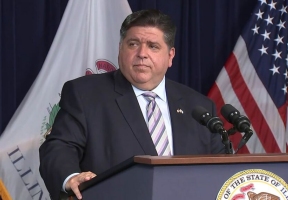Courtesy of Illinois Policy Institute
 It’s been nearly two years since Governor J.B. Pritzker cited emergency powers to issue his first COVID-19 executive order on March 12, 2020. In that time, the governor has extended his emergency powers 26 times through proclamations without input from the Illinois General Assembly. He has also issued 112 executive orders following the establishment of those emergency powers. An Illinois Policy Institute analysis found at least 34 other state legislatures have some sort of check on their governors’ emergency powers. Twenty-two states empower state lawmakers to end a state of emergency by resolution at any time, while 12 states require state legislatures to approve any extension of emergency declarations. “Emergency powers were meant to be used in the direst times, which they were in the early days of the pandemic. It allows executives to act quickly and decisively compared to legislatures, which are deliberative bodies by nature,” said Joe Tabor, senior policy analyst at the Illinois Policy Institute. “But two years is far past the time when the virus was a new and unexpected threat to public health. It’s time for Illinois to act like most other states and allow the legislature to act as a check on the governor’s overreach in his use of emergency powers.”
It’s been nearly two years since Governor J.B. Pritzker cited emergency powers to issue his first COVID-19 executive order on March 12, 2020. In that time, the governor has extended his emergency powers 26 times through proclamations without input from the Illinois General Assembly. He has also issued 112 executive orders following the establishment of those emergency powers. An Illinois Policy Institute analysis found at least 34 other state legislatures have some sort of check on their governors’ emergency powers. Twenty-two states empower state lawmakers to end a state of emergency by resolution at any time, while 12 states require state legislatures to approve any extension of emergency declarations. “Emergency powers were meant to be used in the direst times, which they were in the early days of the pandemic. It allows executives to act quickly and decisively compared to legislatures, which are deliberative bodies by nature,” said Joe Tabor, senior policy analyst at the Illinois Policy Institute. “But two years is far past the time when the virus was a new and unexpected threat to public health. It’s time for Illinois to act like most other states and allow the legislature to act as a check on the governor’s overreach in his use of emergency powers.”
How it works: The Illinois Emergency Management Agency Act limits the governor’s disaster proclamations to 30 days, but allows him to reissue new emergency proclamations each time the previous ones expire. This has been done 27 times in total by Pritzker during COVID-19. There were 112 emergency executive orders issued in that time, enacting policies on masking, closing businesses, requiring vaccinations and more.
How to move forward: Illinois law does not currently give lawmakers oversight of a governor’s emergency powers, as most other states do. Illinois Policy Institute experts recommend the General Assembly gain the power to terminate a governor’s emergency powers by a joint resolution passed by both chambers. The General Assembly’s approval should also be required to extend a disaster proclamation after 30 days.
To read the full analysis, visit www.illin.is/emergencypowers












